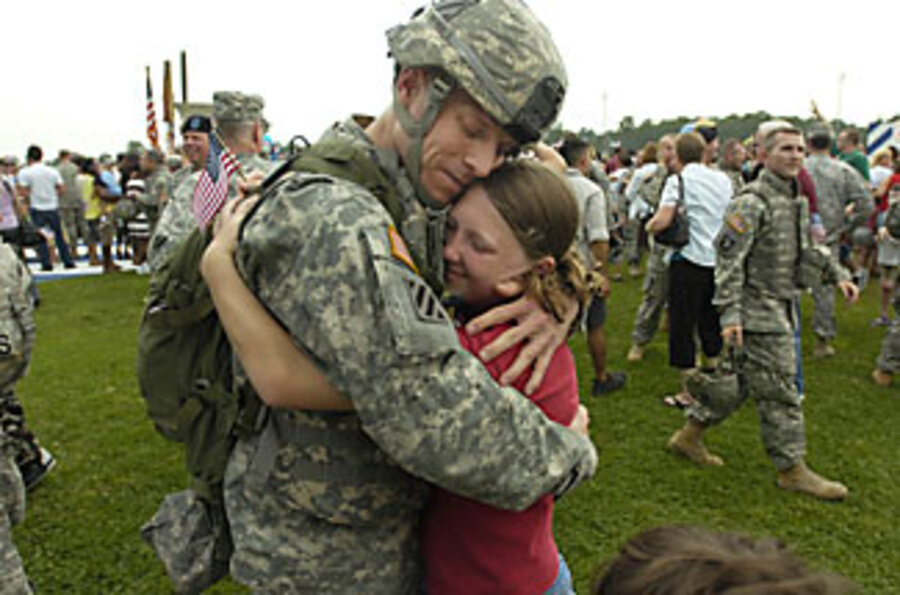With Iraq toll down, U.S. more optimistic
| Washington
The "surge" of American troops in Iraq last year winds to a close next month when the last two surge brigades redeploy home.
Security conditions in the Iraq they are leaving are much improved over those the extra troops encountered when they arrived, say analysts and defense officials, many of whom are confident that trend will continue even without the extra US troops.
The departure of the two brigades comes as the number of American casualties is at a new low. Of the heavy fighting that continues in Iraq, in places like Basra and the Baghdad suburb of Sadr City, much is now being led by the Iraqis themselves. As a result, the number of US casualties last month fell to 19, a number not seen since February 2004, according to icasualties.org.
The toll among Iraqi security forces has also fallen, from 980 in March to 506 in May.
"The conditions in Baghdad are changing," says Maj. Gen. Jeffrey Hammond, the American leading the Bagdad command. "There's no place for those terrorists and criminals. The people are fed up with them. They're tired of the violence and destruction. They vote to move on."
Three of the five combat brigades that made up the surge of US troops announced in January 2007 and deployed by last spring have returned home without being replaced. Currently, 4th Stryker Brigade, 2nd Infantry Divison of Fort Lewis, Wa., has begun to leave Iraq and the 2nd Brigade, 3rd ID, Fort Stweart, Ga., leaving 15 combat brigades there for the foreseeable future.
Gen. David Petraeus, the top commander in Iraq, indicated last month that he plans to recommend withdrawing more forces by year-end.
Some analysts caution that as each brigade is sent home, American forces are spread thinner, leaving the positive security trends the surge helped create all the more vulnerable.
Withdrawing forces always poses risk to the overall mission, says Kimberly Kagan, who has taught at the Military Academy at West Point and is president of the Institute for the Study of War, a think tank in Washington. However, the approach of removing combat forces one battalion at a time is helping keep the withdrawal "focused and well-managed," she says.
Provincial elections to be held late this year may pose a security challenge, she says, adding it would be better to leave those brigades in Iraq longer if possible. General Petraeus believes there will be enough Iraqi and American forces available to monitor any related violence.
"I would want to minimize the risk in those situations, but that said, I don't think the risk we're taking now is too much," she says.
There have also been previous lulls in violence but US officials are more optimistic that the current progress will stabilize because of a combination of factors including increased Iraqi security forces and moves toward political reconciliation.
As the remaining two brigades leave over the next two months, senior US commanders will engage in a "battlefield calculus" to ensure they manage the drawdown without leaving any one area weak, uniformed officials say.
At the same time, Iraqi security forces, which have grown by as many as 126,000 over the last year, have stepped up, more so perhaps than at any other time. As a result, Iraqi and American forces have gone after Shiite militias in Baghdad and Basra as well as Al Qaeda networks north of Baghdad.
"We've been drawing down ... while at the same time, the trends are still supporting the drawdown," says Col. Steven Boylan, a spokesman for Petraeus. "We've been doing this while sustaining the security situation and having some major operations going on."
As each battalion in a brigade vacates an area, the void is filled by extending US units already on the ground and by deploying Iraqi units that officials say were not up to the task even six months ago. Indeed, US forces attribute some of the drop in their casualties to the increased presence and capabilities of Iraqi forces.
But logistical shortfalls mean US commanders must take a nuanced approach as they draw down, ensuring that enough military police, supply, intelligence, and maintenance personnel stay behind to aid the Iraqis as their own combat forces stand up, say military officials.
The challenge of building up Iraqi logistical or noncombat capabilities is a critical factor as the two countries discuss the contentious issue of US long-term presence.
The budding abilities of the Iraqi security forces have for years taken on a familiar, little-engine-that-could tone as supporters of US policy there trumpet each sign of progress.
But officials say recent operations illustrate genuine improvement. Operations in Sadr City, in which the government of Nouri al-Maliki sent Iraqi forces into the Shiite enclave to rout Shiite militias, put Iraqi capabilities on high-profile display. The same was true for operations in Basra in March, in which the US served more as combat adviser than battlefield partner.





